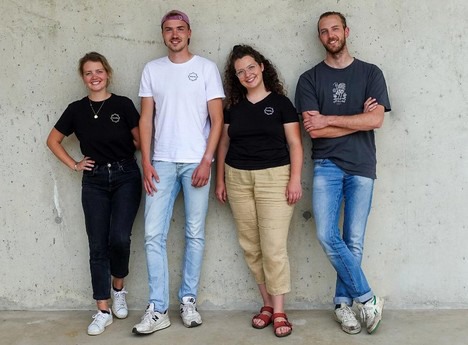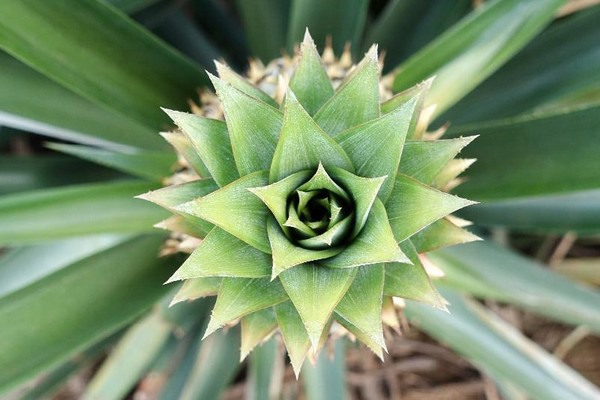In Costa Rican pineapple cultivation, tons of waste are generated every year, with not only the crowns of the fruit but also the leafy plants having to be disposed of. In 2019, a team of students from Leibniz Universität Hannover developed a sophisticated process to recycle this waste into high-quality paper. Soon, the first pilot plant is to be put into operation, and by 2026, up to 5,000 tons per year are to be recycled on site in Costa Rica, according to the ambitious goal.
For a good year now, the former student initiative has been operating as a fully-fledged limited liability company, named eco:fibr. In the meantime, the team has received several awards. Among other things, it received the one-year Exist Gründungsstipendium grant from the German government. The latest round of funding was also successfully completed in May. "In total, we raised 340,000 euros through seven business angels. These private investors not only bring money, but they also enrich us with production experience and know-how from different fields," says Merit Ulmer, co-founder and managing director of the young company.

The eco:fibr team: from left to right Michelle Spitzer, Niklas Tegtmeier, Merit Ulmer & Julian Kolbeck.
Commissioning of the pilot plant
A pilot plant is currently being built in close cooperation with the Hanover-based Institute for Multiphase Processes (IMP) so that the technology can be scaled up from laboratory to pre-industrial scale. Ulmer: "Right from the start, it was particularly important for us to develop holistic processes so that the pineapple plant can be fully utilized. We optimized our system accordingly in close exchange with the producers at the origin, but also with our potential customers from the paper industry. We have now been able to win over two pilot customers and a further 24 interested parties for our technology. This also shows that the paper sector has an extreme need for alternative raw materials. So our process not only offers a solution approach to the waste problem at origin, but we also meet a certain customer need."
A period of two years is initially planned for the pilot plant, says Niklas Tegtmeier, also a co-founder of eco:fibr GmbH and a driving force from the very beginning. "During this period, we will produce about two tons of pineapple fiber, which will be used for a wide variety of test products, such as artist paper and other specialty papers. Ideally, the raw materials would later also be used for the production of fruit and vegetable packaging. That would be a well-rounded idea. In the long term, I also think it's possible."
 Left: Dried pineapple plants
Left: Dried pineapple plants
Right: Burned plants as it is still common in Costa Rica
Transport from the field to processing
The next step is to build a demonstration plant on site in Costa Rica, which is scheduled to come on stream in 2026. In the future, up to 5,000 tons of pineapple fiber per year will be produced here. Tegtmeier: "The biggest challenge we currently face is transport from the field to processing. The plants are still mainly dried, shredded and staggered in the field. However, if we want to extract pulp from the plants, the plants ideally need to come down from the field in a compact form."
To date, there are only manual methods for doing this, which in turn are extremely cumbersome and costly, he said. "We would also like to join forces with those facing the same challenge so that we can work together to find solutions and significantly reduce the time as well as manpower required."
 Only 'green' pineapple plants such as the one pictured here are suitable for further processing.
Only 'green' pineapple plants such as the one pictured here are suitable for further processing.
Other areas of application
The long-term strategy and objective of eco:fibr is to extend the process to other areas, Ulmer continues. "Basic requirements for further utilization are, on the one hand, a low lignin content, i.e. the product must not be too 'woody'. On the other hand, the respective plants must have grown for a short time, about one to two years. So if someone has a residual material, we are also open to contact and initial contact."
The simple plant technology is particularly advantageous, Tegtmeier emphasizes. "The plant is decentralized, or modular, so they can be set up in close proximity to the plantations. Given that we only use products with a low lignin content, fewer chemicals are used in the final fiber extraction with correspondingly lower temperatures. This in turn contributes to lower energy consumption. What must also be remembered is that wood has numerous uses with a decreasing availability of raw materials. This makes it all the more important to develop and implement sustainable alternatives."
Further Information:

Merit Ulmer & Niklas Tegtmeier
eco:fibr GmbH
Walderseestraße 7
30163 Hannover
contact@ecofibr.de
www.ecofibr.de
